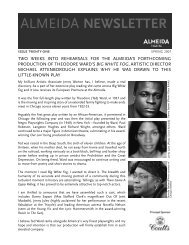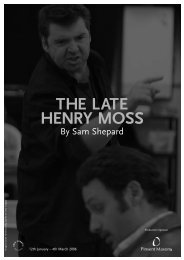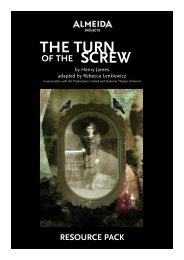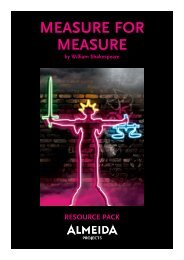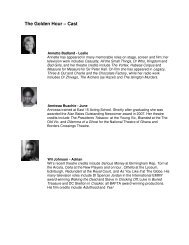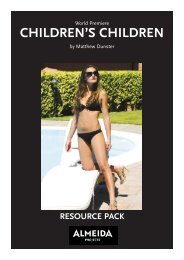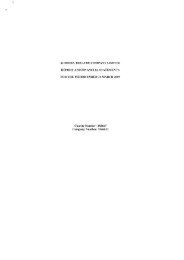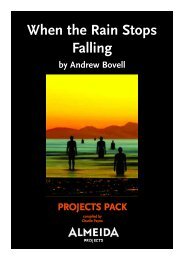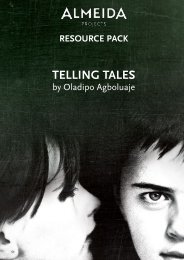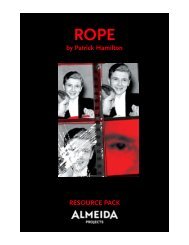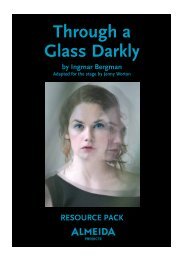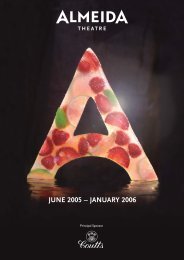to download the production programme as a PDF ... - Almeida Theatre
to download the production programme as a PDF ... - Almeida Theatre
to download the production programme as a PDF ... - Almeida Theatre
You also want an ePaper? Increase the reach of your titles
YUMPU automatically turns print PDFs into web optimized ePapers that Google loves.
Musical references in Duet for One<br />
Throughout <strong>the</strong> play <strong>the</strong>re are<br />
numerous references <strong>to</strong> composers,<br />
players and musical styles.<br />
8<br />
Johann Seb<strong>as</strong>tian Bach (1685 – 1750), a<br />
German composer and organist whose<br />
sacred and secular works for choir,<br />
orchestra, and solo instruments drew<br />
<strong>to</strong>ge<strong>the</strong>r <strong>the</strong> strands of <strong>the</strong> Baroque<br />
period and brought it <strong>to</strong> its ultimate<br />
maturity. While Bach’s fame <strong>as</strong> an<br />
organist w<strong>as</strong> great during his lifetime,<br />
he w<strong>as</strong> not particularly well-known <strong>as</strong> a<br />
composer. A revival of interest and<br />
performances of his music began early<br />
in <strong>the</strong> 19th century, and he is now<br />
widely considered <strong>to</strong> be one of <strong>the</strong><br />
greatest composers in <strong>the</strong> Western<br />
tradition, his works revered for <strong>the</strong>ir<br />
intellectual depth, technical command<br />
and artistic beauty. The Sonat<strong>as</strong> and<br />
Partit<strong>as</strong> for solo violin heard during <strong>the</strong><br />
course of this <strong>production</strong> were<br />
composed in 1720.<br />
Ludwig van Beethoven (1770 – 1827), a<br />
German composer and pianist. He w<strong>as</strong><br />
a crucial figure in <strong>the</strong> transitional<br />
period between <strong>the</strong> Cl<strong>as</strong>sical and<br />
Romantic er<strong>as</strong> in Western cl<strong>as</strong>sical<br />
music, and remains one of <strong>the</strong> most<br />
respected and influential composers of<br />
all time. Born in Bonn, he moved <strong>to</strong><br />
Vienna in his early twenties and settled<br />
<strong>the</strong>re, studying with Joseph Haydn and<br />
quickly gaining a reputation <strong>as</strong> a<br />
virtuoso pianist. Beethoven’s hearing<br />
gradually deteriorated beginning in his<br />
twenties, yet he continued <strong>to</strong> compose,<br />
and <strong>to</strong> conduct and perform, even after<br />
he w<strong>as</strong> completely deaf. The recorded<br />
cadenza which Feldmann puts on in<br />
Act Two is from <strong>the</strong> Third Movement of<br />
Beethoven’s Violin Concer<strong>to</strong>, op. 61.<br />
Niccolò Paganini (1782 – 1840), an<br />
Italian violinist, violist, guitarist, and<br />
composer. He w<strong>as</strong> one of <strong>the</strong> most<br />
celebrated violin virtuosi of his time,<br />
and left his mark <strong>as</strong> one of <strong>the</strong> pillars of<br />
modern violin technique.<br />
Felix Mendelssohn (1809 –1847), a<br />
German composer, pianist and<br />
conduc<strong>to</strong>r of <strong>the</strong> early Romantic period.<br />
The grandson of <strong>the</strong> philosopher<br />
Moses Mendelssohn, he w<strong>as</strong> born <strong>to</strong> a<br />
notable Jewish family which later<br />
converted <strong>to</strong> Christianity. His work<br />
includes symphonies, concerti,<br />
ora<strong>to</strong>rios, piano and chamber music.<br />
After a long period of relative<br />
denigration due <strong>to</strong> changing musical<br />
t<strong>as</strong>tes and antisemitism in <strong>the</strong> late 19th<br />
and early 20th centuries, his creative<br />
originality is now being recognized and<br />
re-evaluated.<br />
J<strong>as</strong>cha Heifetz (1901 – 1987), a Jewish<br />
violin virtuoso born in Lithuania; <strong>the</strong><br />
son of a violin teacher and<br />
concertm<strong>as</strong>ter he w<strong>as</strong> a child prodigy<br />
who <strong>to</strong>ok up <strong>the</strong> violin when he w<strong>as</strong><br />
three years old, made his public debut<br />
at seven, and entered <strong>the</strong> St Petersburg<br />
Conserva<strong>to</strong>ry <strong>to</strong> study under Leopold<br />
Auer when he w<strong>as</strong> nine. Heifetz soon<br />
gained fame in Europe and in his teens<br />
became a sensation in America, later<br />
settling <strong>the</strong>re and obtaining citizenship<br />
in 1925. He h<strong>as</strong> been hailed <strong>as</strong> <strong>the</strong><br />
greatest violinist of <strong>the</strong> 20th century.<br />
Isaac Stern (1920 – 2001), a Jewish<br />
violin virtuoso born in <strong>the</strong> Ukraine.<br />
His family moved <strong>to</strong> San Francisco<br />
when he w<strong>as</strong> an infant, and he<br />
completed much of his training at <strong>the</strong><br />
San Francisco Academy of Music.<br />
Within musical circles, Stern became<br />
renowned both for his recordings and<br />
for championing promising younger<br />
players. Among his discoveries were<br />
cellists Yo-Yo Ma and Jian Wang, and<br />
violinists Itzhak Perlman and Pinch<strong>as</strong><br />
Zukerman. He also played a major<br />
role in saving New York City’s<br />
Carnegie Hall from demolition in<br />
1960, which later had its main<br />
audi<strong>to</strong>rium named in his honour.<br />
Itzhak Perlman (1945 —) is an Israeli-<br />
American violin virtuoso, conduc<strong>to</strong>r,<br />
and teacher. Born in Tel Aviv, he<br />
studied <strong>the</strong>re before moving <strong>to</strong> <strong>the</strong><br />
United States <strong>to</strong> study at <strong>the</strong> Juilliard<br />
School. He made his debut at<br />
Carnegie Hall in 1963 and won <strong>the</strong><br />
prestigious Leventritt Competition in<br />
1964. While primarily a solo artist,<br />
Perlman h<strong>as</strong> <strong>to</strong>ured with <strong>the</strong> Israel<br />
Philharmonic Orchestra, and<br />
collaborated with a number of notable<br />
musicians. In recent years, Perlman<br />
h<strong>as</strong> also begun <strong>to</strong> conduct, and in<br />
2007 w<strong>as</strong> appointed Artistic Direc<strong>to</strong>r<br />
and Principal Conduc<strong>to</strong>r of<br />
Westchester Philharmonic. Perlman<br />
also teaches, having held several<br />
faculty posts and chairs, and founding<br />
<strong>the</strong> Perlman Music Program in New<br />
York for gifted young string players<br />
in 1995.<br />
Pho<strong>to</strong> by John Godfrey



